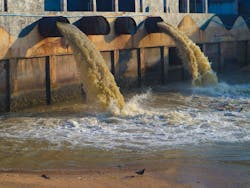Rice University Researches Ammonia Removal from Wastewater
Collaborators at Rice University’s George R. Brown School of Engineering, Arizona State University and Pacific Northwest National Laboratory developed a catalyst that can pull ammonia and solid ammonia from low levels of nitrates. These nitrates are found in industrial wastewater and polluted groundwater, reported Rice University.
According to Rice University, the study is led by Rice chemical and biomolecular engineer Haotian Wang.
The process converts nitrate levels of 2,000 parts per million into ammonia, then undergoes a gas stripping process for ammonia product collection, and then the remaining nitrogen contents after these treatments can produce drinkable levels of water.
“We fulfilled a complete water denitrification process,” said graduate student Feng-Yang Chen, reported Rice University. “With further water treatment on other contaminants, we can potentially turn industrial wastewater back to drinking water. We knew that ruthenium was a good metal candidate for nitrate reduction, but we also knew there was a big problem, that it could easily have a competing reaction, which is hydrogen evolution. When we applied current, a lot of the electrons would just go to hydrogen, not the product we want.”
Chen is one of three lead authors of the paper.
According to the researchers, previous studies showed that ruthenium atoms can catalyze nitrate-rich wastewater, reported Rice University. The team combined it with copper that suppresses the hydrogen evolution reaction.
“We borrowed a concept from other fields like carbon dioxide reduction, which uses copper to suppress hydrogen evolution,” added Wang, reported Rice University. “Then we had to find a way to organically combine ruthenium and copper. It turns out that dispersing single ruthenium atoms into the copper matrix works the best.”
“When there is only ruthenium, the water gets in the way,” said co-corresponding author Christopher Muhich, an assistant professor of chemical engineering at Arizona State, reported Rice University. “When there is only copper, there isn’t enough water to provide hydrogen atoms. But on the single ruthenium sites water doesn’t compete as well, providing just enough hydrogen without taking up spots for nitrate to react.”
The process reduces carbon dioxide emissions from traditional industrial production of ammonia, according to the researchers.
“While we understood that converting nitrate wastes to ammonia may not be able to fully replace the existing ammonia industry in the short term, we believe this process could make significant contributions to decentralized ammonia production, especially in places with high nitrate sources,” said Wang, reported Rice University.
Co-lead authors of the Nature Nanotechnology paper include: Rice postdoctoral fellow Zhen-Yu Wu and Srishti Gupta, a graduate student at Arizona State University. Co-authors are graduate student Daniel Rivera of Arizona State; Sten Lambeets of the Pacific Northwest National Laboratory, Richland, Washington; research scientist Guanhui Gao, undergraduate Stephanie Pecaut, graduate students Jung Yoon Kim and Peng Zhu, and Yimo Han, an assistant professor of materials science and nanoengineering, at Rice; Zou Finfrock, Hua Zhou and Wenqian Xu of Argonne National Laboratory, Lemont, Illinois; Debora Motta Meira and Graham King of Canadian Light Source, Saskatoon, Saskatchewan; and David Cullen of Oak Ridge National Laboratory, Oak Ridge, Tennessee.
Additionally, Rice University reported that Daniel Perea of the Pacific Northwest lab is a co-corresponding author of the paper. Wang is the William March Rice Trustee Chair and an assistant professor of chemical and biomolecular engineering.
